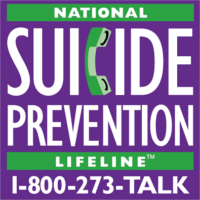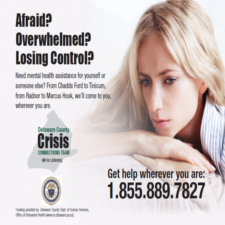Prevention Principles
These principles are from “Suicide Prevention: Prevention, Effectiveness, and Evaluation” (Atlanta, GA: SPAN USA, 2001):
“Prevention programs should be designed to enhance protective factors.”
“Family-focused prevention efforts may have a greater impact than strategies that focus only on individuals.”
“Community programs need to strengthen norms that support help-seeking behavior in all settings, including family, work, school, and community.”
“Prevention programming should be adapted to address the specific nature of the problem in the local community.”
“Community programs that include media campaigns and policy changes are more effective when individual and family interventions accompany them.”
Common Myths about Suicide
“Those who talk about suicide won’t do it.”
“Telling someone to do it will snap them out of it.”
“Suicide attempters really want to die.”
“Talking about suicide will give some ideas’.”
“Suicide victims were all psychotic.”
“Most suicides occur with no warning.”
“If someone is suicidal, she/he will be so forever.”
“Someone who has attempted suicide won’t try again.”
“People who say they’re suicidal only want attention.”
Realities about Suicide
- Many who talk about suicide complete suicide.
- This is the single most dangerous thing to do.
- Suicidal people want to end their suffering.
- Talking about suicide shows that you care.
- Most suicidal people are in touch with reality.
- Many suicidal victims show warning signs.
- Suicidality is not permanent; it will pass.
- Most victims have made one or more attempts.
- Suicidal behavior is often a “plea for help.”

Suicide Warning Signs
Warning signs indicate that someone may be suicidal. They show that something is very wrong. Though they appear clear and concrete they are often hard to see in someone that we are close to or in ourselves. Warning signs are not always present, but it is important that they be identified when they are evident.
- Hopelessness, worthlessness, feeling a loss of control, helplessness
- Threatening to harm oneself or completing suicide
- Having a definite plan for completing suicide
- Acquiring the means to complete suicide (e.g, getting a gun)
- Rehearsing or visiting a place to complete suicide
- Increased use of alcohol and/or drugs
- Changes in eating, sleeping, and personal care Apathy, lack of energy, inability to focus
- Talking or writing about death, drawing images of death
- Withdrawing from social relationships or activities
- Losing interest in hobbies, work, school
- Giving away highly valued personal items or possessions
- Undergoing significant changes in mood and personality
- Engaging in reckless or dangerous behaviors
- Making a will, funeral arrangements, or telling others how affairs should be handled
Suicide Risk Factors
- A prior suicide attempt
- Experiencing a serious personal loss
- Family history of suicide
- History of abuse, abusiveness, or family violence
- Severe depressive episode Long-term depression or other serious mental illness
- Having a dual diagnosis (i.e., mental illness and substance abuse)
- Using/abusing alcohol, drugs, or other substances
- Having a disabling and/or chronic illness and/or severe pain
- Being arrested, jailed, or imprisoned

Suicidal Behavior Triggers
Certain stressful events may bring about suicidal behavior. These are “triggers.” They are things that happen to or around an individual. They may push someone with one or more risk factors toward suicidality.
Some common triggers are:
- The break up of a close personal relationship (e.g., engagement or marriage),losing old friends, or interpersonal conflicts
- The death of a close relative or friend
- Suicide loss, especially a child, parent, spouse, or sibling
- Financial loss or incurring major indebtedness
- Rejection (e.g., not getting a job or promotion, not be accepted to a college or graduate school, etc.)
- Loss of self-esteem or status (e.g., losing a job, failing at school, being cut from a team, etc.) or feeling humiliated.
- Becoming seriously ill or disabled
- Facing arrest, trial, prison, or other legal difficulty
It is thought that triggers interact with risk factors to produce suicidal thoughts (ideation), which may lead to other more serious forms of suicidal behavior.
Protective Factors
Protective factors are things about an individual’s personality, background, beliefs and values, social or family situation, environment, and so forth that can help in preventing or overcoming suicidal feelings. They enhance an individual’s response to chronic stress or traumatic events in her/his life. They are related to the concept of “resilience.”
Some protective factors are:
- Optimism and a positive orientation towards the future
- Good coping capability
- Strong problem-solving skills
- Willingness to readily seek and accept help
- A good sense of self-esteem and self-worth
- Strong spiritual values and religious ties
- Close family or social bonds
- Emotional stability (i.e., not being impulsive or short-tempered)
Key Definitions of Suicide
The Task Force has adopted the following terminology recommended in S.K. Goldsmith et al. (Eds.), Reducing Suicide: A National Imperative (Washington, DC: Institute of Medicine, 2002):
“Suicide: Fatal self-inflicted destructive act with explicit or inferred intent to die.”
“Suicide Attempt: A non-fatal, self-inflicted destructive act with explicit or inferred intent to die.”
“Suicidal Ideation: Thoughts of harming or killing oneself.”
“Suicidal Communication: Direct or indirect expressions of suicidal ideation or of intent to harm or kill oneself, expressed verbally or through writing, artwork, or other means.”
“Suicidality: All suicide-related behaviors and thoughts including completing or attempting suicide, suicidal ideation or communications.”
